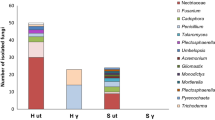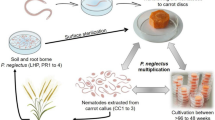Abstract
IN an earlier paper1 various symptoms of wound-tumour disease, such as stunting, vein enlargement, leaf distortion and tumours, were described on several of the numerous hosts of the causal virus Aureogenus magnivena Black2. The present communication deals principally with the role of wounds in tumour inception in diseased plants. Fig. 1 illustrates the kind and number of tumours present on the roots of infected sweet clover (Melilotus alba Desr.). A cross-section through a root bearing a tumour (Fig. 2) shows the practically normal portion of the root enclosed within the black line. In this area the parts are, for the most part, regularly arranged. The rest of the section is tumour tissue. It shows several centres of growth, the margins of which are marked by deeply stained meristematic cells with prominent nuclei. The meristematic cells are surrounded by a layer of crushed cells and enclose parenchyma and vascular elements. The xylem is prominent and reveals the highly disorganised condition of the tumour tissue. It may be arranged in whorls or it may be so disorganised that two adjacent xylem elements are disoriented in regard to each other. Affected cells frequently show spherical bodies that stain intensely with safranin. No organisms have been observed in such sections.
This is a preview of subscription content, access via your institution
Access options
Subscribe to this journal
Receive 51 print issues and online access
$199.00 per year
only $3.90 per issue
Buy this article
- Purchase on Springer Link
- Instant access to full article PDF
Prices may be subject to local taxes which are calculated during checkout
Similar content being viewed by others
References
Black, L. M., Amer. J. Bot., 32, 408 (1945).
Black, L. M., Proc. Amer. Phil. Soc., 88, 132 (1944).
White, P. R., "A Handbook of Plant Tissue Culture" (J. Cattell Press, 1943).
Rawlins, T. E., and Tompkins, C. M., Phytopath., 26 578 (1936).
Rous, P., "Viruses and Tumours", in "Virus Diseases", 147–170 (Messenger Lectures, Cornell Univ. Press, 1943).
Author information
Authors and Affiliations
Rights and permissions
About this article
Cite this article
BLACK, L. Plant Tumours Induced by the Combined Action of Wounds and Virus. Nature 158, 56–57 (1946). https://doi.org/10.1038/158056b0
Issue Date:
DOI: https://doi.org/10.1038/158056b0
This article is cited by
-
Plant tissue culture: A history
The Botanical Magazine Tokyo (1983)
-
Effect of Aspartic Acid on Growth of Plant-Virus Tumour Tissue
Nature (1950)
-
Plant Tumours and Animal Cancer
Nature (1947)
Comments
By submitting a comment you agree to abide by our Terms and Community Guidelines. If you find something abusive or that does not comply with our terms or guidelines please flag it as inappropriate.



